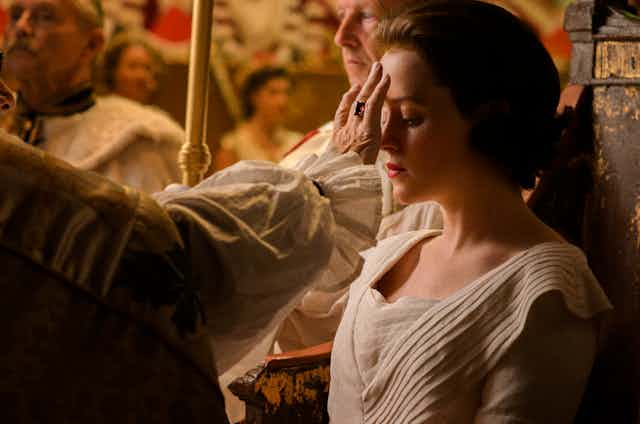Information about King Charles III’s coronation is coming out bit by bit from who will do what to the choice of music and the coronation emoji design.
One fact was never in doubt: we can watch it on television.
Queen Elizabeth II’s coronation in 1953 drew 20 million viewers on the BBC. Behind the scenes there were fierce arguments about televising the service. Prime Minister Winston Churchill opposed the idea.
The 27-year-old queen insisted there would be cameras inside Westminster Abbey. But one thing was clear: the cameras would avert their gaze at the most sacred moment of the ceremony.
Everyone agreed the anointing, the moment the monarch becomes sacred, was too holy for television cameras.
In 2023, coronation planners feel the same: the cameras will again avert their gaze as Archbishop Justin Welby anoints Charles III.
But while this will only be the second British coronation to be televised, popular culture has provided many opportunities to see fictional depictions.
Coronations on the screen
Elizabeth (1998) about Queen Elizabeth I had a major set piece as the crown was placed on the queen’s head even as there was turmoil in her 16th-century kingdom.
In close-up, Elizabeth closes her eyes and draws on her inner strength as the crown and sceptre are handed to her and her political enemies watch with hostility.
In England My England (1995) the coronation of Charles II in 1685 is farcical, as the king processes behind an ancient and tottering archbishop.
The King’s Speech (2010) showed behind-the-scenes preparation for George VI’s coronation in 1937, including George’s concerns at speaking without a stutter.
The tasteful planning in 1953 to preserve the holiness of the coronation contrasts with other versions of the coronation on British television. British television’s respect in 1953 has given way to parody, comedy and sensationalism.
One of the most outrageously disrespectful depictions of a televised coronation is a 1977 episode of the famous comedy series The Goodies. The Goodies made their parody of the coronation in the year of Elizabeth’s silver jubilee in an episode packed with bizarre and disrespectful comedy.
The actual royal family are injured when performing an entertainment routine and so it is up to one of the Goodies, Tim Brooke-Taylor, to impersonate the injured queen in a re-creation of the coronation.
Another Goodie (also a man) takes the place of Princess Anne. Because of budget cuts, everyone at Westminster Abbey is a cardboard cut-out.
In a chase scene between the royal family and the Goodies, the false Princess Anne leaps on the back of the Archbishop of Canterbury and makes him canter around a field.
There was more comedy and more disrespect in King Ralph (1991), which not only showed the death by electrocution of the entire royal family but also the crown placed on the head of a loud-mouthed American slob who was the only surviving heir to the throne. He then promptly wore it in a bubble bath.
More serious in tone, The Crown in 2016 showed what the BBC’s cameras did not in 1953 with close-up views of the most sacred moments of the ceremony. The high-definition cameras make viewers close and intimate when the 1953 ceremony was veiled and sacred.
In 2009 the drama series The Queen showed Elizabeth II’s accession and coronation not as holy but as part of domestic drama and scandal.
Like both the comedy of the Goodies and the drama of The Crown, it showed both a coronation and a royal family that had shifted from the sacred to the profane. Public ritual masked the private dramas in the royal family including Princess Margaret’s liaison with a divorced man.
Most serious of all, the 2017 television film King Charles III imagined a near future where Charles comes to the throne only to cause political chaos through erratic and unconstitutional acts.
Controversial because it showed Charles’s reign as brief and turbulent, and forced to abdicate by William, the film ends with Charles disgruntled and cast aside, gate-crashing William’s coronation and slamming the crown down on William’s head.
Charles III’s coronation will be a magnificent spectacle. But today’s television viewers will also know the real-life soap opera behind the scenes of today’s royal family. Whether we laugh at comedy or are absorbed by drama, we have seen television as less than respectful of sacred mysteries.
Read more: From fairytale to gothic ghost story: how 40 years of biopics showed Princess Diana on screen

